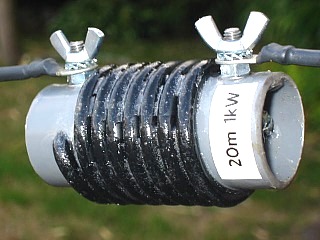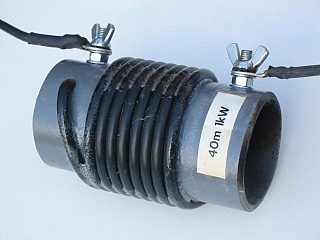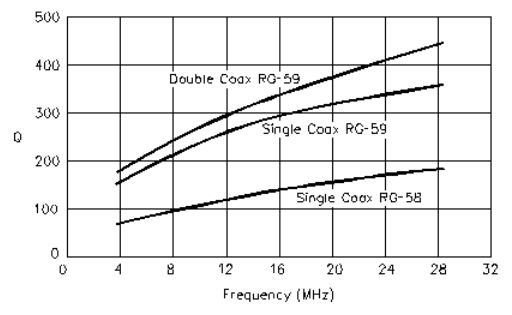 |
|
Bill of Materials (for 2 traps):
-
2 PVC sewage pipes, Outer Diameter (OD) 32
(50)(32)
mm, 80 (95)(80)
mm long each, thick walled (3mm) and resistant to heat
(95°) version.
-
4 bolts with nuts, M5x15 or M5x17 (zinc anodized
or Stainless Steel for permanent use)
-
4 'grower' M5 (teethed washers)
-
4 washers M5 (zinc anodized or Stainless Steel
for permanent use)
-
4 butterfly nuts M5 (zinc anodized or Stainless
Steel for permanent use)
-
4 big washers M5 , outer diameter 25mm. Use ZINC
ANODIZED IRON if you want to solder directly on them, if you use
copper or stainless steel , you will need a eye lug to solder
the coax and connect to the M5 bolts.(recommended for high power).
-
186
(306)(134) cm COAX CABLE
type RG-58 C/U (the type is critical, use C/U
version, to have same capacitance per meter and power handling)
|
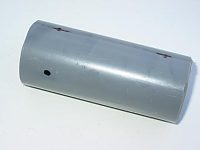 |
|
Preparation of the pipes:
- Mark 2 holes in-line (these are for the bolts), at
13 (15)
(13)mm
from each end of pipe
- Mark 2 holes (these for coax), at 13mm from each end of pipe,
and for 20m trap 90° on each side of the two holes for the bolts (so
the coax holes will be 180° opposite) /
For 40m trap, at 32mm distance along the
circumference, on each side of the marks for bolt holes.
For 15m, same construction as for 20m.
|
 |
|
Drill all 4 holes with 5mm and remove sharp edges
with a trimmer, especially for the coax holes |
 |
|
Preparation of the the 4 big washers:
- These are used for mechanical strength and connecting the coax
ends to terminal bolts
- Remove zinc anodization on 1/2 of washer surface (as soldering
is very difficult and unreliable on anodized zinc). Use a grinder or
file.
|
 |
|
Now this will be the area where we will solder
the coax ends |
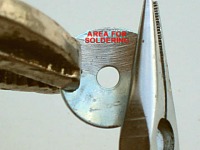 |
|
Using 2 pliers, bend the washer so that it will
fit inside the PVC tube. Keep the area for soldering as depicted! |
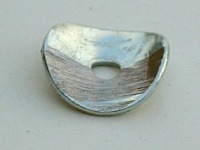 |
|
This will be the result (4 pces), adjust till they
nicely fit inside the PVC tube. |
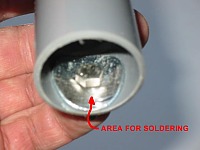 |
|
Now insert the 4 big washers in the tube ends,
keep the area for soldering on the outer side, and insert the M5 bolts. |
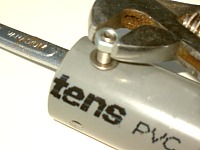 |
|
Now put the small washer and M5 nut on the bolts
and tighten very well with appropriate tools.
We are now ready to start to wind our coax coils ! |
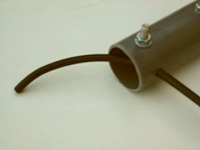 |
|
Take 93 (153)
(67)
cm of RG-58C/U coax
for each coil. Insert approx 10 cm in the hole for the 'start'. RG-58C/U
will just pass in a 5mm hole. |
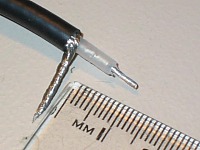 |
|
Remove insulation on 15mm of the end passed
through pipe and prepare tail like shown |
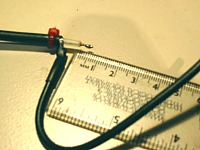 |
|
On the shield, solder a small hookup wire length
120mm about (take at least same gauge as coax center wire) and cover
with heat shrink tube. Put a small nylon fastener 3mm after the start of
coax outer jacket (here in the picture in red). |
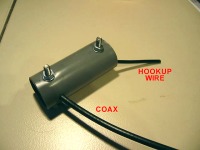 |
|
Now gently retract the coax in the tube, while
inserting the hookup wire till it comes out of the tube on the other
side, and the coax cannot be pulled out any more (nylon fastener) |
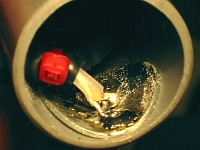 |
|
Now solder (a 60w iron should be OK) the coax
center on the big washer. Make sure you have a good bond, but do not
overheat as the coax / PVC will melt... |
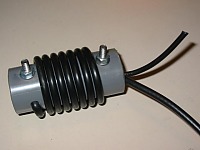 |
|
Now start to wind the coil !
- tightly wind the coax around the PVC tube, till you have 7,5
turns (8,7 turns)
(5,5 turns widely spaced, spread over tube),
where the coax will enter the PVC tube again
- spread evenly the windings for 20m trap, keep them 'tight' for
40m trap
- make sure the coax outer windings are at least 3mm from the
connection bolts/nuts
|
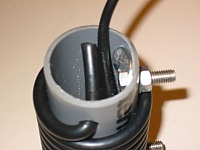 |
|
Use the short remaining end of coax to pull is as
much as possible inside the tube and have windings sitting tight.
Then cut off the coax so you have 20mm left inside the tube. |
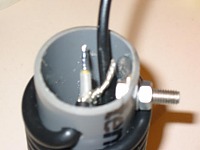 |
|
Using a cutter knife delicately around outer
jacket, remove insulation on about 15mm and prepare coax ends like
shown. |
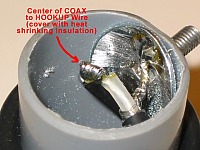 |
|
-
Solder the coax shield to the big washer
-
Solder the coax centre to the hookup wire , which
you will have cut till desired length (make it as short as possible)
-
Cover this solder joint with heat shrink tube,
immediately after heating it up, squeeze firmly with pliers the free
end to seal off the tube.
-
important: check if both M5 nuts are still
well tightened (they will loosen with the heat !)
Your coax trap is now ready to be tuned ! |
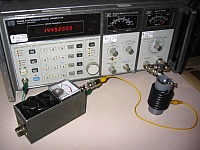 |
|
How to tune the traps ?
-
Use a grid-dipper (but must be accurate to 100
kHz at least)
-
Use a signal generator and put the trap in series
with a RF voltmeter, a field strength meter input, .... and look for
minimum signal (= resonance)
-
Use a transceiver with adjustable low power
(5w ?), connect the trap in series with a power meter/dummy
load, or a small bulb (like of bicycle rear light), and look for
minimum lighting up (= resonance)
-
Tune both traps at 15
(7.3)
(22)
MHz
by playing with the coil windings (closer to
each other = lower frequency). You will see that the dip is quite
broad.
-
Try to distribute the windings evenly till all
looks nice - this will as well distribute the dissipated heat evenly
and prevent arcing. Make sure the coax outer windings remain
at least 3mm from the connection bolts/nuts.
|
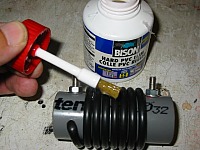 |
|
Once the resonance is OK and the trap is looking
fine, apply PVC glue (this glue is used for mounting PVC tubing, it is
clear, dries in minutes and becomes quite hard after hours) on the
windings, especially on the outer turns of the coil, and a couple of
strokes in the longitudinal direction. Liberally apply 2 or 3 coats of
glue as well on the coil inside (soldering points, coax ends, big
washers etc. to weather protect these elements). The recheck the
resonance point : it will not have moved due to the glue. |
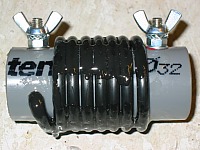 |
|
Put the 5mm 'grower' washers and the butterfly
nuts in place (with some Vaseline grease as protection against rust) :
your
COAXTRAP is now ready ! Apply a label indicating the band it has
been designed for as the 'finishing touch' ! |
